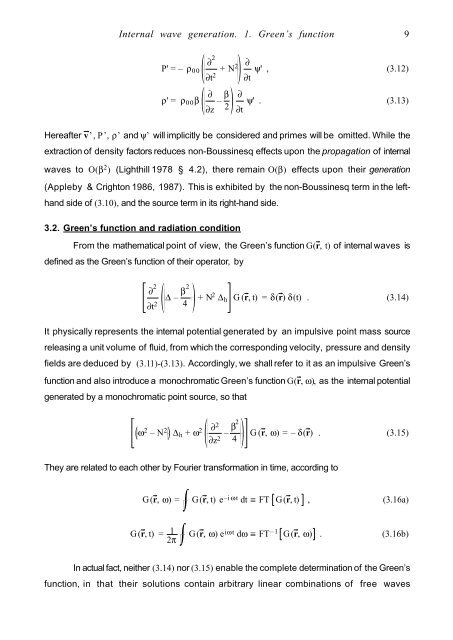Internal Wave Generation in Uniformly Stratified Fluids. 1 ... - LEGI
Internal Wave Generation in Uniformly Stratified Fluids. 1 ... - LEGI
Internal Wave Generation in Uniformly Stratified Fluids. 1 ... - LEGI
You also want an ePaper? Increase the reach of your titles
YUMPU automatically turns print PDFs into web optimized ePapers that Google loves.
<strong>Internal</strong> wave generation. 1. Green’s function 9<br />
P' = – ρ00 ∂2 ∂<br />
+ N2 ψ' , (3.12)<br />
∂t2 ∂t<br />
ρ' = ρ00β ∂<br />
∂z<br />
– β<br />
2 ∂<br />
∂t<br />
ψ' . (3.13)<br />
Hereafter v’, P’, ρ’ and ψ’ will implicitly be considered and primes will be omitted. While the<br />
extraction of density factors reduces non-Bouss<strong>in</strong>esq effects upon the propagation of <strong>in</strong>ternal<br />
waves to O(β 2 ) (Lighthill 1978 § 4.2), there rema<strong>in</strong> O(β) effects upon their generation<br />
(Appleby & Crighton 1986, 1987). This is exhibited by the non-Bouss<strong>in</strong>esq term <strong>in</strong> the left-<br />
hand side of (3.10), and the source term <strong>in</strong> its right-hand side.<br />
3.2. Green’s function and radiation condition<br />
From the mathematical po<strong>in</strong>t of view, the Green’s function G(r, t) of <strong>in</strong>ternal waves is<br />
def<strong>in</strong>ed as the Green’s function of their operator, by<br />
∂ 2<br />
β2<br />
Δ –<br />
∂t2 4 + N2 Δh G (r, t) = δ(r) δ(t) . (3.14)<br />
It physically represents the <strong>in</strong>ternal potential generated by an impulsive po<strong>in</strong>t mass source<br />
releas<strong>in</strong>g a unit volume of fluid, from which the correspond<strong>in</strong>g velocity, pressure and density<br />
fields are deduced by (3.11)-(3.13). Accord<strong>in</strong>gly, we shall refer to it as an impulsive Green’s<br />
function and also <strong>in</strong>troduce a monochromatic Green’s function G(r, ω), as the <strong>in</strong>ternal potential<br />
generated by a monochromatic po<strong>in</strong>t source, so that<br />
ω 2 – N 2 Δh + ω<br />
2 ∂2 β2<br />
–<br />
2<br />
∂z<br />
4<br />
G (r, ω) = – δ(r) . (3.15)<br />
They are related to each other by Fourier transformation <strong>in</strong> time, accord<strong>in</strong>g to<br />
G(r, ω) = G(r, t) e –i ωt dt ≡ FT G(r, t) , (3.16a)<br />
G(r, t) = 1<br />
2π G(r, ω) eiωt dω ≡ FT –1 G(r, ω) . (3.16b)<br />
In actual fact, neither (3.14) nor (3.15) enable the complete determ<strong>in</strong>ation of the Green’s<br />
function, <strong>in</strong> that their solutions conta<strong>in</strong> arbitrary l<strong>in</strong>ear comb<strong>in</strong>ations of free waves


